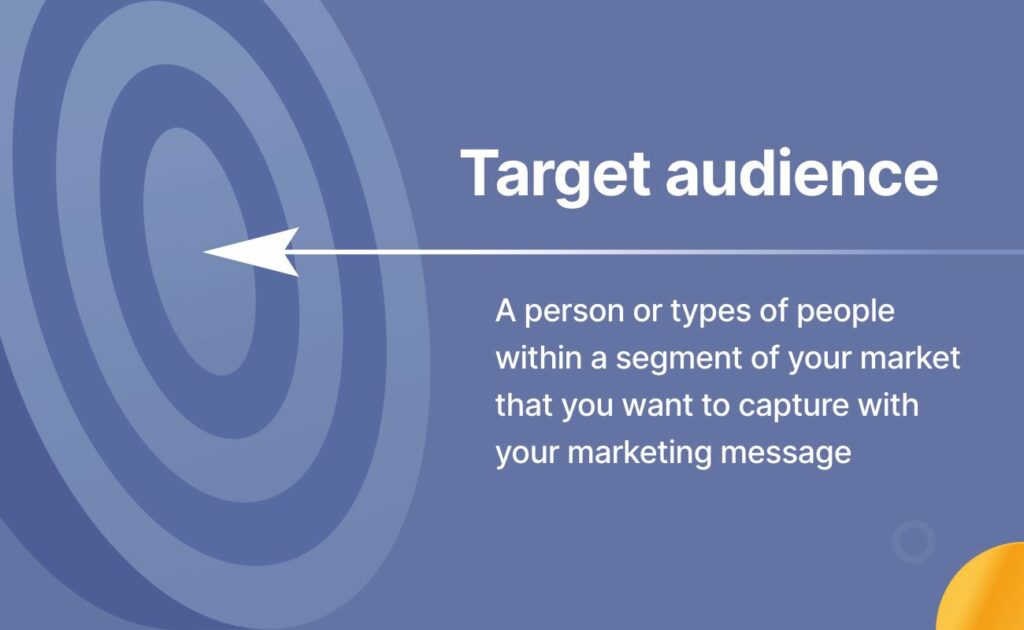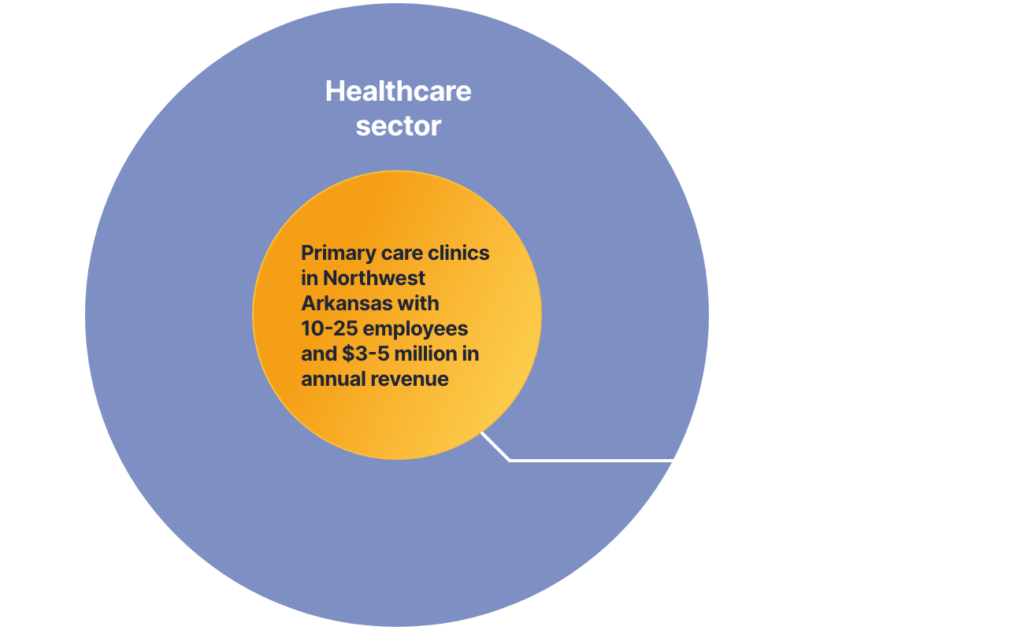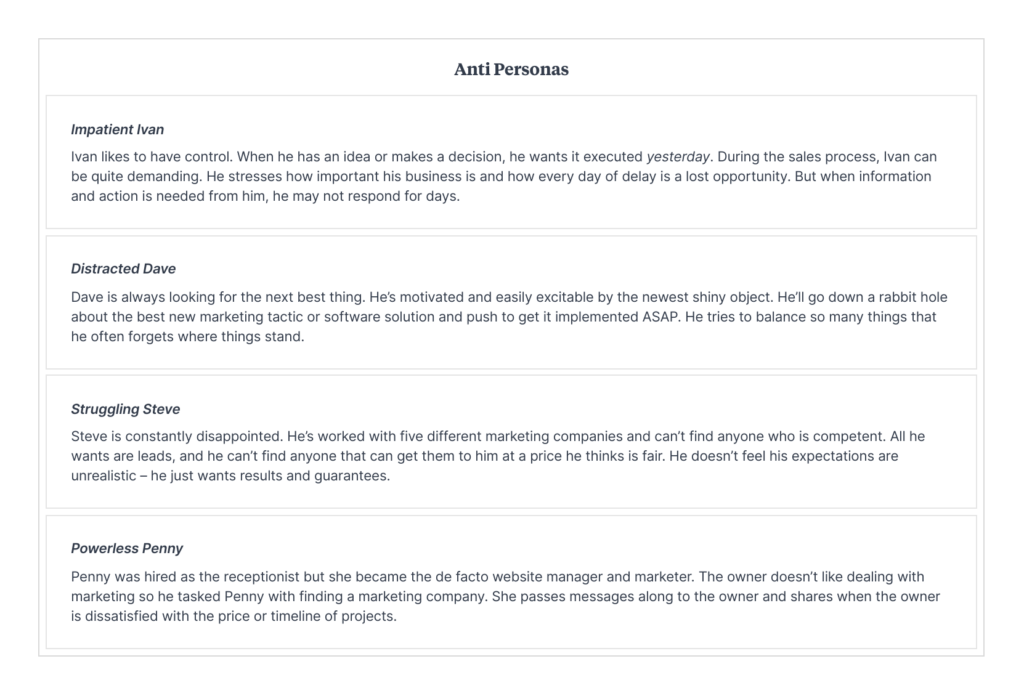If I had six hours to chop down a tree, I’d spend the first four hours sharpening the axe.
— Abraham Lincoln
To be effective and efficient in any endeavor, you need to properly prepare your tools; otherwise, you’ll waste time and effort and end up with an incomplete or botched job. The same applies to digital marketing: tools like websites, email outreach, pay-per-click advertising, and social media are only effective if “sharpened” for a clearly defined target audience.
What is a target audience?
A target audience is a person or types of people within a segment of your market that you want to capture with your marketing message. They share commonalities such as occupation, location, age, or other demographic factors. They also share common goals, challenges, and needs that your product or service can solve.

Example of a target audience
For example, a target market segment for an IT services company might be small to medium-sized automotive manufacturers with 25–500 employees and over $5 million in annual revenue.
The target audience in this segment would consist of the key decision makers and influential stakeholders, such as:
- Members of the C-suite or organizational leadership teams like the CEO, CIO and CFO – They have the final say about whether or not to purchase a product or service.
- People in operations roles like HR, administration, or office managers – They know firsthand how IT affects daily operations and could be a champion for switching IT providers.
- Internal IT leaders – They might not have the time or resources to properly oversee all aspects of their IT and could benefit from outsourcing some of their responsibilities.
Having a profile for each of these stakeholders in the buying process is extremely valuable, especially when employing content marketing strategies. A CFO would be interested in white papers and data that shows how they can reduce their operating expenses by switching IT providers. A person in HR might be interested in a blog post about streamlining employee onboarding using technology. An IT Director could benefit from a webinar about how to attract and retain talented IT professionals. As we shall see, creating these profiles — knowns as buyer personas — is an essential step in the process of defining your target market.
Why should I define my target audience?
At this point, you might be asking yourself, “Who is my target audience?” If the answer is something like, “We’ll offer our services to anyone who wants them” or “I serve small businesses in my area,” then you don’t have a target audience. You are trying to appeal to the broadest possible audience, which is as effective as targeting nobody in particular.
Defining your target audience lays the foundation for effective marketing. It will help you engage key decision makers and stakeholders and eventually convert them into loyal customers. Bypassing this step will result in an unclear message that doesn’t resonate with key decision makers, a website that doesn’t show up in search results, ads that don’t convert, and ultimately, an exhausted marketing budget with little to show for it.
Now that you’re aware of the potential ramifications, let’s look at the steps to defining your target audience.
Step 1. Identify your critical market segments
The first step in defining a target audience is identifying the market segments that promise significant opportunities. Focusing on a few key segments enables you to invest your finite time and resources into areas with the greatest potential for success.
Start by taking a closer look at your existing customer base
Look at your current customer base and note which market sectors you serve today. Definitions vary, but let’s work with these 10:
- Consumer Goods and Services
- Energy
- Financial, Legal, and other Professional Services
- Healthcare and Biosciences
- IT and Communication
- Manufacturing
- Materials
- Government, Education, and Military
- Real Estate
- Utilities
Identifying the market sectors you serve is a great start. However, many people make the mistake of trying to market to an entire sector. To create an effective marketing message, you need to dig deeper by highlighting the specific industries and types of businesses you serve in each market sector. Since there are approximately 90 industries across all market sectors, it’s crucial to get very clear about which ones you serve.
For example:
“In the Healthcare sector, we serve primary care clinics.”
“In the Financial and Professional Services sector, we serve insurance and law firms.”
“In the Manufacturing sector, we serve automotive manufacturers.”
To get even more specific, research these details:
- Company Size: You don’t need exact numbers, but a headcount range is useful. Small businesses are usually defined as having fewer than 100 employees, while mid-sized businesses range from 100 to 999 employees. As a general rule, smaller organizations need a different set of solutions compared to enterprise-level companies.
- Industry sub-specialties: Avoid lumping your customers into one category. An automotive manufacturer that sells directly to consumers will have a much different set of problems compared to a commercial vehicle and machinery manufacturer that depends on government contracts.
- Location: Understanding the location of your customers will allow you to assess the competitiveness of the market and know if there are additional opportunities nearby.
- Revenue: Understanding your customers’ financial resources will help you gauge if they have the ability to afford your services or not.
You should end up with something like this:
“In the Healthcare sector, we serve primary care clinics in Northwest Arkansas with 10–25 employees and $3–5 million in annual revenue.”
“In the Financial and Professional Services sector, we serve B2B law firms in Pasadena with 50–150 employees and $5+ million in annual revenue.”
“In the Manufacturing sector, we serve B2G machinery manufacturers in the Inland Empire with over 250 employees and $8–10 million in annual revenue.”

Evaluate your target market segments
Now that you have a better understanding of your target markets, you will need to verify which of them are worth serving.
Ask yourself the following questions:
- Can I easily get in contact with decision makers and influencers?
- Do I have expertise in this market segment, and can I demonstrate it?
- Are there enough prospects in this market segment to sustain our business?
- Is there much competition for this market segment?
- Am I comfortable with the length of the sales cycle in this segment?
- Will customers from this segment stay with us for a long time and/or repeatedly use our services?
- Do customers from this market segment have a greater lifetime value than other segments?
- Is the typical ratio of acquisition cost vs. profit margin justified?
Answering these questions will help you identify the highest-potential segments — the ones worth investing your marketing efforts in.
How does market segmentation help with marketing?
Dividing your market into distinct groups and picking your most promising segments lets you dive deeper into the specific needs and challenges that they are facing. This thorough dissection and evaluation process allows you to reach your target customer with customized campaigns that highlight their needs.
Your marketing efforts will also be more effective because you will weed out difficult market segments where acquisition and/or retention is low. As a result, your return on investment will be higher.
Step 2. Create buyer personas based on your existing customers
Now that you’ve identified your market segments with long-term potential, it’s time to uncover the needs, expectations, and problems you solve for customers in each segment. To define this target audience, we make profiles of imaginary but realistic people who match the target characteristics. These profiles are usually based on existing customers and known as buyer personas.
The easiest way to get started is to put yourself in the shoes of actual customers — the individuals you serve today. If you have many customers to choose from, focus on your “favorite” customers first — those with a high NPS (net promoter score) or CSAT ranking. These are the people who are the best fit for your products or services. They’re also the ones who are likely to recommend you to other potential customers.
If you don’t have any customer feedback data, use your interactions with them or feedback from teams who interact with them to choose your targets.
By this point, you should have a few people in mind, so here’s how to complete your customer profiles:
Include your customers’ demographic information
Demographic information lets you get granular about who to target:
- How old are they?
- What is their gender?
- Where are they located?
- What is their income level?
- What is their marital status?
- Do they have any children?
- What are their hobbies and interests?
Some of these details may seem unconnected to your offerings. But the essence of digital marketing is creating content that resonates with your target customers, appeals to them, and draws them toward you. These are real people with real motivations and frustrations. Using demographic information to create your personas makes them more personal. This will impact the tone and words you use to speak to these people, and give you a better chance of connecting with them. It also improves advertising effectiveness by helping with targeting on platforms like Google, Facebook, and LinkedIn.
Identify your customers’ needs and problems
Challenges and pains reveal what problems your product or service should solve for your customers:
- What motivated them to buy from you in the first place?
- What was the primary problem that you solved for them?
- What was at risk if they didn’t solve the problem?
Recount their role in the buying and decision-making process
Knowing how a buying decision was made will let you send the right message to the right people:
- How did they find out about your company?
- What made them consider your products/services?
- Did they hold the purse strings or did they influence the decision makers?
- What was their first impression of your company?
- Why did they end up choosing your company over your competitors?
- What reservations or concerns did they have?
- Were they budget-conscious or happy to pay?
Consider the psychographics of your target customers
Psychographics give a more personalized view of an individual and include:
- Personality
- Attitudes
- Values
- Interests/Hobbies
- Lifestyles
- Behavior
Determine where else your customers can find you
Last but not least, think about how else your customers are likely to find your business:
- What websites do they visit?
- What blogs do they read?
- Which social media sites do they frequently visit?
- What search terms might they use to find services like yours?
- What kind of content appeals to them?
You should end up with something like this:

Learning more about your customers’ online behaviors will give you insight into how you can create valuable content for them and which channels to use to target them.
Once you have done this, you should have a clearly defined ideal customer profile. Repeat the process until you have profiles for all your key market segments, and you’ll soon have a very sharp “marketing spear.”
Using our FREE buyer persona tool, you can create personas in 5 minutes or less. Just answer a few basic questions and we’ll email you a professional and editable persona instantly.
Bonus step: Create anti-personas
Defining who isn’t a good fit for your products or services can be just as important as knowing your ideal customers.
Anti-personas are people who think they are in your target audience but actually aren’t. That means they have similar challenges and problems as your target audience, but also have characteristics that make them a bad fit. Here are some examples of characteristics that could make someone an anti-persona:
- They don’t have enough budget and often haggle about prices.
- They misunderstand the scope of your product or service, which results in complaints.
- They cost too much to acquire and retain.
- They offer little long-term potential because they frequently jump from one provider or service to another.
How do I create an anti-persona?
An anti-persona can be created in the same way as a target customer profile — by looking at the key characteristics, motivations, and frustrations of your bad-fit customers.
Once again, it’s helpful to glean insights from your customer-facing teams. Look at who gives you poor NPS scores and note down the traits that make these customers a bad fit.
Note: Make sure to distinguish between customers who are unhappy because of an aspect of your service that can be improved and those who shouldn’t have been customers in the first place. The latter are the bad-fit customers.
Here are examples of anti-personas for marketing consulting services:

How would anti-personas affect my marketing?
Knowing the traits of an anti-persona will allow you to be more transparent in your messaging and deter or re-route potential bad fits. Here are a couple of ways to deter a bad fit:
- FAQ pages can be a great way to inform people and potentially discourage bad fits from considering a product or service that isn’t suited for them.
- Gathering information with form fields on company size, years in operation, and annual revenue can weed out prospects that are too small (or too big) and redirect them to alternative providers.
Step 3. Analyze your competitors’ marketing and messaging
What better way to learn more about your target audience than examining what the competition is doing? Explore competitor websites and take note of the following:
- Is their content aimed at the same audience you’re trying to reach?
- What are the pain points or desired outcomes that they describe?
- Are there any guarantees or other reassurances? They are probably trying to appeal to their target audience and minimize the risks they might be worried about.
- Do they have an FAQ section? This is where they might address conversion-critical questions from prospects.
- What are their pricing levels and how do they compare to your own?
- How are their online reviews? If there are things that your competitors aren’t good at, you can position yourself as someone who solves those problems.
Researching your competitors’ websites will help you better understand what other challenges your target audience faces and how to better market to them. It’s an effective way to spot trends in your target market and plan proactive service rollouts and marketing campaigns.
Summary
Having a clearly defined target audience is vital for the success of your marketing and the growth of your business. By defining your target audience, you’ve taken the first step to becoming more visible and relevant to them.
FAQ
The short answer is constantly. The market is always evolving and your target audience is evolving along with it. Markets may seem stable, then transition occurs. You can’t just define your target audience once and then forget about it in a desk drawer or deeply buried folder. As you interact with more customers and notice new challenges or problems, make sure you’re keeping notes so you can adapt existing buyer personas or create new ones. This way, you’ll always be aware of new challenges and how to solve them.
If you have no paying customers yet, you’re dealing with assumptions and educated guesses based on your first-hand experience and anecdotal evidence. It may be helpful to learn from other businesses in a similar position and adapt their strategies depending on your circumstances to get results.
Perform a quick search for the product or service you are offering and identify the top websites that rank for the search term in your area. Ask yourself if their product or service overlaps with what you provide and if they are going after the same target audience. If the answer is yes, then mark them as a competitor.
To learn more about your audience, use Google Analytics to explore your website’s traffic and perform a deep audience analysis. You can use custom reports to find demographic and psychographic data as well as geographic locations and the types of technology your customers use.